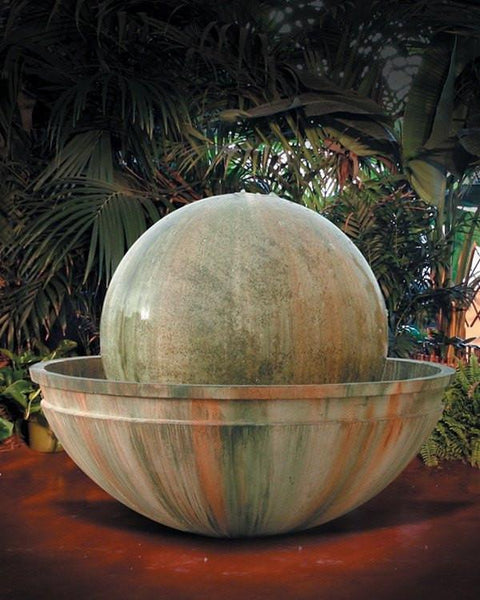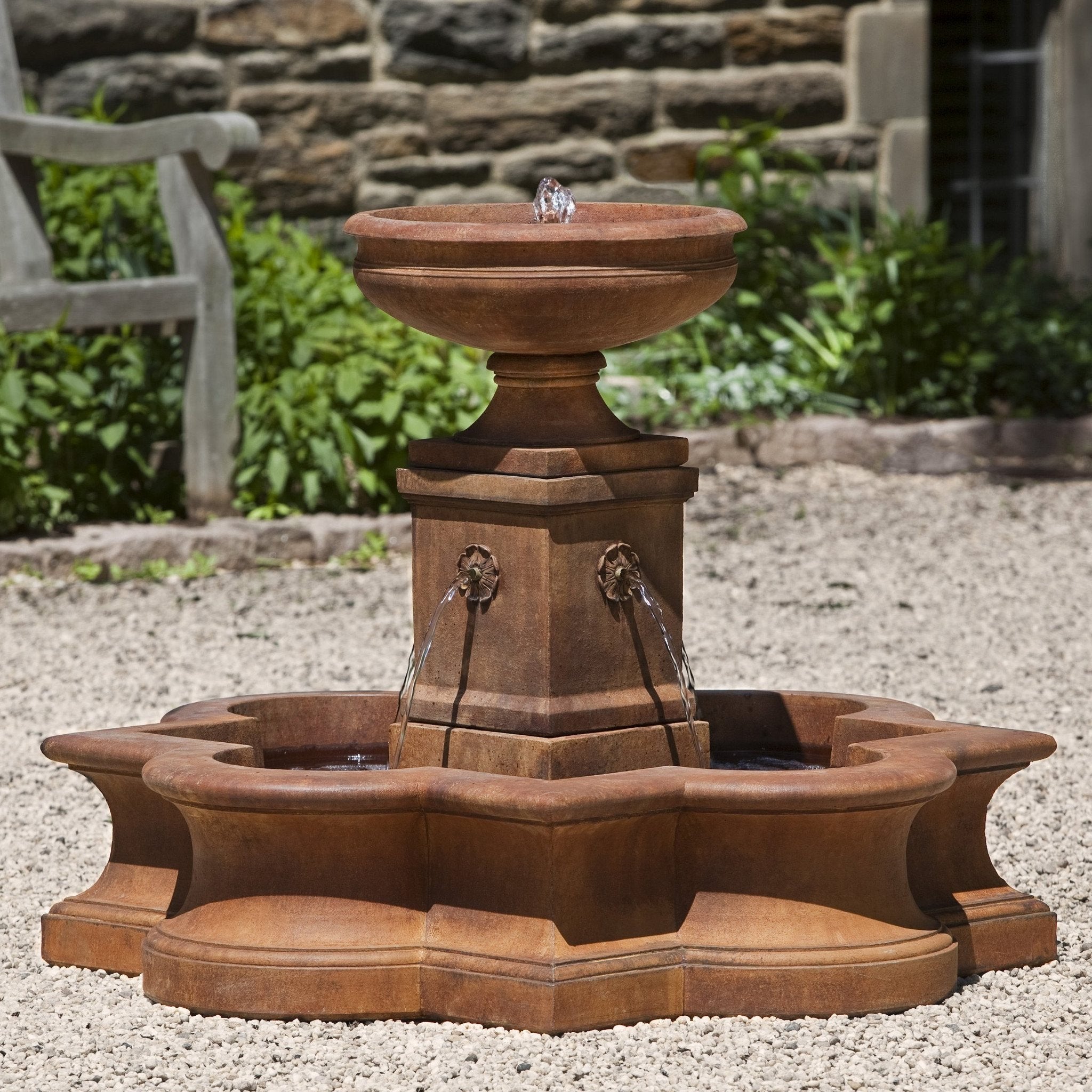Outdoor fountains are beautiful pieces of art that can be used to spruce up a backyard of any size. These fountains sometimes have sculptures or recognizable figurines as a part of their design. The size of outdoor water fountains will typically depend on your personal preferences. Perhaps you enjoy small and compact fountains over larger ones. However, the scale of the fountain will also depend on the size of your yard. Often, the question is raised in regards to how outdoor water fountains can be cleaned. Smaller fountains will take less time to clean, unless there are lots of intricate details that require more time. On the other hand, larger fountains have more water and room for buildup. We will be discussing more specifics in the article below!

Read The Manufacturer’s Instructions
This is the easiest and one of the most important parts of your intensive algae treatment procedures. Different fountains require different chemicals and using the wrong chemical to clean your fountain can result in irreversible damage to your beloved water feature.
Drain Your Fountain
Once you have read the maintenance instructions that came with your fountain and you fully understand what chemicals are safe to use and how to disassemble your pump, you are ready to begin draining your fountain. Depending on the size of your fountain, a wet/dry vac may be required to get the fountain basin completely drained. Be sure to unplug your pump prior to draining your water fountain or you can burn out the pump's motor.
Rinse Your Fountain
Rinse your fountain with clean water. Make sure to clear all the lines by running the water through the lines. Use a rag and water to rinse your fountain and see what algae stains may require additional attention in order to be removed.

Clean Your Pump
Carefully remove your pump from your water fountain. Take it to a well-lit area and disassemble the pump according to the manufacturer's instructions. An old toothbrush can provide you with a very efficient way to clean the hard to reach places within your pump. Be sure that you don't use any chemicals that are not listed as approved by the manufacturer and it is very important that you rinse your pump off to remove any soap. Soap can ruin a pump in less than a day, so it is critically important that you rinse your unit off completely.
Clean all Spouts and Tubing
Cleaning the pipes and tubing of your fountain can require special tools. Pipe cleaners are one of the cheapest and most effective ways to get your tubing clean. Make sure fully clean each tube to prevent blockage. A blocked line can burn your pump out and even cause leaks within your tubing system. Avoid these problems by inspecting all of your tubings after a thorough cleaning.
Clean the Fountain Basin
Go back over your fountain basin with fresh water. Depending on the material that your fountain is made from, you may be able to use high-pressure washing techniques. Cast stone fountains can be pressure washed for an extra clean look.
Scrub Stains Out
Some stains are going to be stubborn and require a little more attention to remove. These stains can be removed with the use of a toothbrush and an approved cleaning agent. If you do not have access to any fountain basin cleaner, dish soap can work for most stains but some elbow grease may be required.
Rinse Your Fountain
Now rinse your fountain to remove any chemicals from the fountains walls. Take your wet/dry vacuum and remove all of the water from the basin again. Inspect your fountains basin to ensure that all stains have been removed. Algae can come back quickly so you need to be sure that you have completely removed any algae from your fountain during this process.

Add an Algae Prevention Schedule
Now that you have completed your intensive algae clean-up process, you are probably thinking to yourself "How can I avoid doing all of this work again in the near future?" That’s an easy question to answer, simply begin an algae prevention schedule.
You should give your fountain a regular cleaning every three months to prevent any algae from gaining hold onto your fountains basin or pump. Placing your fountain in an area that has significant shade can also help to slow algae growth. Algae will grow where ever there is water and sun but in cool shaded areas, algae grow at a much slower pace.
Distilled water can be another great addition to consider adding to your alga prevention strategy. This is a great way to avoid using chemical but it can raise your ownership costs a bit.
Using a water additive is the best prevention method you can use to keep your fountain looking nice. These are usually inexpensive, and last a long time. Fountec Algaecide and Clarifier will keep algae away, but is not an abrasive chemical. When used as directed, it is safe for all animals, including birds and pets who like to drink out of your fountain. It's an excellent choice to maintain clean water that can attract more wildlife to your garden. It is a little too strong for fish though. All you do is add a few drops each week depending on the size of your fountain and it keeps algae under control.

How To Keep Outdoor Fountain Water Clean?
Maintaining the clarity of your outdoor water fountain water is achievable through the strategic use of aquatic plants. These plants serve a dual purpose by absorbing the nutrients and toxins that algae thrive on, effectively deterring algae growth. Additionally, their presence contributes to water aeration, further aiding in the prevention of algae proliferation. Beyond their functional benefits, aquatic plants also enhance the aesthetic appeal of your backyard fountain, transforming it into a captivating and visually pleasing feature that complements the overall beauty of your outdoor space.
Should I Leave My Fountain On All The Time?
The decision to keep your fountain running constantly depends on factors like personal preference, budget, and fountain type. Running it continuously can deter algae growth and maintain water quality. However, this may increase electricity costs and lead to more wear and tear on the fountain components. Finding a balance that suits your aesthetics and budget is essential. Or you can go solar and save yourself the trouble. Benefit from the simplicity of how solar fountains work, which harnesses sunlight to power the water feature without the need for complex wiring or electrical connections.
How to Prevent White Scale in Outdoor Water Fountains?
Preventing white scale buildup in outdoor fountains is crucial for their appearance and functionality. Regular cleaning, use of water softeners, and monitoring water chemistry can help combat this issue. Periodic maintenance ensures your fountain stays visually appealing and operational.
What is the Best Type of Water to Use?
The best water for your outdoor water feature depends on local water quality. Generally, filtered or distilled water is recommended to minimize mineral deposits. However, tap water may suffice if it's not excessively hard. Regular water quality checks and maintenance are key for a trouble-free fountain.
How to Fix A Leaking Fountain?
Fixing a leaking fountain involves identifying the source of the leak, which could be a crack, damaged seal, or loose connection. Drain the fountain, inspect it thoroughly, and apply appropriate sealants or repairs. Seeking professional assistance may be necessary for extensive damage. Regular maintenance and prompt leak repairs ensure your fountain remains functional and attractive.
How Often Should You Clean Your Outdoor Water Fountain?
The frequency of cleaning an outdoor water feature depends on various factors, including the fountain's size, location, and environmental conditions. In general, a thorough cleaning every two to four weeks during the active season (spring through fall) is a good starting point. However, closely monitor the fountain's water quality and appearance. If you notice algae growth, debris accumulation, or water discoloration, clean it more frequently. Additionally, consider a more comprehensive cleaning and maintenance routine, including pump and filter maintenance, at the start and end of the outdoor water fountain season to keep it in pristine condition and prevent potential issues.
Reviving the Elegance of Your Outdoor Fountain
Cleaning your outdoor water fountain is not just about maintenance; it's a rejuvenating experience for your landscape. In this comprehensive guide, we've explored the step-by-step process of cleaning your outdoor water feature, from draining and scrubbing to treating and refilling. By following these instructions and adopting a regular cleaning routine, you can ensure that your fountain remains a captivating centerpiece, reflecting its beauty and serenity into your outdoor space for years to come. With each cleaning session, you're not only removing debris but also refreshing the essence of tranquility in your garden or patio.

